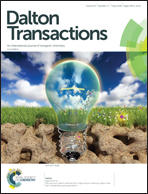Cd/In-Codoped TiO2 nanochips for high-efficiency photocatalytic dye degradation†
Abstract
Titanium dioxide has been widely investigated in the field of photocatalysis research. However, the wide bandgap (3.2 eV) greatly limits its practical applications because only ultraviolet light can be absorbed by bare TiO2. Herein, we report a facile approach to prepare Cd/In-codoped TiO2 nanochips with the capability of visible light absorption. Such bimetallic-doped TiO2 was synthesized through a two-step process: Cd/In/S-TiO2 gels were first synthesized by mixing the preformed Cd–In–S supertetrahedral nanoclusters with a titanium source, and the subsequent pyrolytic process effectively converted the gels into Cd/In-TiO2 nanochips with a thickness of ∼2.19 nm and a uniform diameter of ∼10.60 nm. Interestingly, the absorption band of Cd/In-TiO2 nanochips was adjusted by pyrolysis temperature, which further regulated the photocatalytic efficiency of dye degradation under visible light. Current research demonstrates that doping TiO2 by multimetallic sulfide nanoclusters opens up a new door to further enrich the dopants in TiO2 and broaden their potential applications.



 Please wait while we load your content...
Please wait while we load your content...